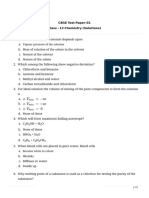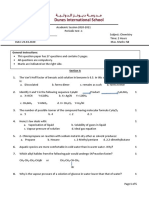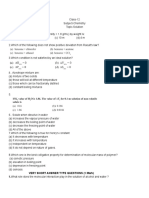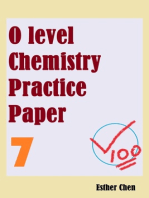Recrystallization and Melting Point Determination of Benzoic Acid
Recrystallization and Melting Point Determination of Benzoic Acid
Uploaded by
Joone Xyron CreenciaCopyright:
Available Formats
Recrystallization and Melting Point Determination of Benzoic Acid
Recrystallization and Melting Point Determination of Benzoic Acid
Uploaded by
Joone Xyron CreenciaOriginal Description:
Original Title
Copyright
Available Formats
Share this document
Did you find this document useful?
Is this content inappropriate?
Copyright:
Available Formats
Recrystallization and Melting Point Determination of Benzoic Acid
Recrystallization and Melting Point Determination of Benzoic Acid
Uploaded by
Joone Xyron CreenciaCopyright:
Available Formats
J. E. Birdwell / Chemistry 31.
1 (2019) P a g e |1
RECRYSTALLIZATION AND MELTING POINT DETERMINATION OF
BENZOIC ACID
Joone Xyron V. Creenciaa,*
aCollege
of Arts and Letters, University of the Philippines, Diliman, Quezon City
Performed 11 January 2019; Submitted 18 January 2019
ANSWERS TO QUESTIONS
1. How does the fluted filter paper hasten filtration?
Answer 1
2. Explain two techniques that can help prevent premature crystallization. What could be the consequences of
premature recrystallization?
Answer 2
3. A mixture containing 2.0 g of A and 8.0 g of B is to be separated by recrystallization. The components were
purified by single crystallization using 100mL of solvent. Their solubilities are given in the table below:
A B
Solvent
Hot Cold Hot Cold
Ethanol 0.5 10.0 5.0 20.0
Acetone 5.0 20.0 0.1 8.0
Water 0.6 15.0 0.5 10.0
a. Which solvent would you choose? Explain your choice by means of a schematic diagram.
b. Theoretically, what is the purity of A and B after one recrystallization?
Answer 3
4. A mixture of three compounds. A, B, and C is purified using recrystallization method.
Their solubilities in g/100mL ethanol are given below:
Solvent A B C
Cold 1.05 5.6 4.2
Hot 20.5 2.3 3.5
a. If a mixture containing 4.0 g each of A, B, and C is recrystallized from 100mL ethanol, which compound
can be obtained pure?
b. If the filtrate from (a) is evaporated to 50mL, which of the compound(s) will separate upon cooling?
What is its purity?
Answer 4
5. You were asked to perform recrystallization using a mixed-solvent system. Which of the following solvents
cannot be used as solvent pairs for the experiment? Explain your answer.
a. Hexane and water
b. Chloroform and diethyl ether
c. Acetone and methanol
Answer 5
*Corresponding author. Mobile: 09051434752
E-mail address: Joone.tempest@gmail.com
J. E. Birdwell / Chemistry 31.1 (2019) P a g e |2
6. What are the advantages/disadvantages of mixed solvent recrystallization over single solvent
recrystallization?
Answer 6
You might also like
- Chem 31.1 ATQ 2Document2 pagesChem 31.1 ATQ 2Mikaela BiolenaNo ratings yet
- Experiment 4 - AmineDocument3 pagesExperiment 4 - AmineFaris SyahmiNo ratings yet
- Cbse Test Paper-01 Class - 12 Chemistry (Solutions) : Vapour Pressure of The SolutionDocument5 pagesCbse Test Paper-01 Class - 12 Chemistry (Solutions) : Vapour Pressure of The SolutionTr Mazhar PunjabiNo ratings yet
- Chemical Engineering Day 1 Pre-BoardDocument4 pagesChemical Engineering Day 1 Pre-BoardAron Balines100% (1)
- Chem 16.1 Problem Set LE2 2019-2020Document5 pagesChem 16.1 Problem Set LE2 2019-2020Javie MikeNo ratings yet
- O Level Biology Practice Questions And Answers EnzymesFrom EverandO Level Biology Practice Questions And Answers EnzymesRating: 5 out of 5 stars5/5 (1)
- FLCD 200 Thesis Proposal Acuna and Dela Pena RevisedDocument94 pagesFLCD 200 Thesis Proposal Acuna and Dela Pena RevisedJoone Xyron CreenciaNo ratings yet
- Lecture 9 Material JettingDocument14 pagesLecture 9 Material Jettingshanur begulaji100% (1)
- Recrystallization and Melting Point Determination of Benzoic AcidDocument3 pagesRecrystallization and Melting Point Determination of Benzoic AcidKarl Brylle CablaidaNo ratings yet
- Experiment 2 PDFDocument2 pagesExperiment 2 PDFJoone Xyron Creencia100% (1)
- Chematq 2Document5 pagesChematq 2Anonymous GO6JVW9Wud100% (5)
- Class Xii Ut I Chemistry (Set 2) 2024-25Document3 pagesClass Xii Ut I Chemistry (Set 2) 2024-25jayashree krishnaNo ratings yet
- Grade 12 Chemistry PT1 2020-21Document5 pagesGrade 12 Chemistry PT1 2020-21Sudha BhatNo ratings yet
- Class Xii Ut I Chemistry (Set 1) 2024-25Document3 pagesClass Xii Ut I Chemistry (Set 1) 2024-25jayashree krishnaNo ratings yet
- Lab Report Organic Chemistry (Experiment 7) Lim Wey LoonDocument24 pagesLab Report Organic Chemistry (Experiment 7) Lim Wey LoonWEY LOON LIMNo ratings yet
- Solution and Colligative Properties Test-1Document2 pagesSolution and Colligative Properties Test-1ratheedhruv33No ratings yet
- Midterm Exam Reviewer (Mas Malala Talaga Ang Real Exam)Document3 pagesMidterm Exam Reviewer (Mas Malala Talaga Ang Real Exam)Ying YangNo ratings yet
- Lahore Grammar College Test Session (2020-2021)Document2 pagesLahore Grammar College Test Session (2020-2021)ABDULLAH BIN AFZAALNo ratings yet
- Chem 1Document8 pagesChem 1Gwen YosheenNo ratings yet
- Problem Set Mock Exam PCPDocument10 pagesProblem Set Mock Exam PCPJeremy Allan Bartolo0% (1)
- Tugas Buat SoalDocument3 pagesTugas Buat Soalaliefyan4769No ratings yet
- Class X Term Ii Fa Science PDFDocument15 pagesClass X Term Ii Fa Science PDFgodwinmodernschoolNo ratings yet
- 1st Sem Organic Sessional-1 Nov. 2023Document12 pages1st Sem Organic Sessional-1 Nov. 2023Biswajit RoyNo ratings yet
- class 10th ch-4Document7 pagesclass 10th ch-4Meenal SinglaNo ratings yet
- Organic Chemistry Practice Test 2B: 10 Items - 15 MinutesDocument1 pageOrganic Chemistry Practice Test 2B: 10 Items - 15 MinutesJelo LacernaNo ratings yet
- CHEMISTRYDocument6 pagesCHEMISTRYkca.craneservicesNo ratings yet
- Get Test Bank for Chemistry Principles and Reactions 7th Edition William L Masterton Download PDF ebook with Full Chapters NowDocument49 pagesGet Test Bank for Chemistry Principles and Reactions 7th Edition William L Masterton Download PDF ebook with Full Chapters Nowstheehurday50100% (12)
- 26.7.2024 SR CBSE PRE FINAL-1 CHEMISTRYDocument9 pages26.7.2024 SR CBSE PRE FINAL-1 CHEMISTRYatharv soorajNo ratings yet
- Postlab 3Document6 pagesPostlab 3Ice cream dudeNo ratings yet
- Summative Test 3 Q 3 Gen - Chem 2 SY 2022 2023 Copy - Edited Copy - Edited.edited Copy - EditedDocument12 pagesSummative Test 3 Q 3 Gen - Chem 2 SY 2022 2023 Copy - Edited Copy - Edited.edited Copy - EditedJV Subang PatindolNo ratings yet
- Chem 16 1 Problem Set LE2 2018 2019 B PDFDocument5 pagesChem 16 1 Problem Set LE2 2018 2019 B PDFJoanna Angela LeeNo ratings yet
- 4477629000000072242_1727598837462_9633948650Document6 pages4477629000000072242_1727598837462_9633948650RachiBro2431No ratings yet
- Tinywow - Worksheet 1 For Class Xii Summer Holiday Homework - 57895346Document4 pagesTinywow - Worksheet 1 For Class Xii Summer Holiday Homework - 57895346nipundayalan12345No ratings yet
- Preparation of IodoformDocument18 pagesPreparation of IodoformHerminHardyantiUtami80% (5)
- Chem Kin + Alcohols Phenols Ethers TPDocument2 pagesChem Kin + Alcohols Phenols Ethers TPlavanya guptaNo ratings yet
- Chemistry 80 AbcdDocument11 pagesChemistry 80 AbcdBereket AsefaNo ratings yet
- Fort ST 2019 Chemistry Trial PaperDocument46 pagesFort ST 2019 Chemistry Trial PaperYuanfeng WeiNo ratings yet
- Chapter - 2 (Solution)Document4 pagesChapter - 2 (Solution)Acoustify -MusicNo ratings yet
- Organic Chemistry QuizDocument4 pagesOrganic Chemistry QuizSujayJain100% (1)
- 2019 Giraween Chemistry Trial ExamDocument24 pages2019 Giraween Chemistry Trial ExamJane YooNo ratings yet
- Montly Test Paper FromatDocument4 pagesMontly Test Paper FromatNeethu JitheshNo ratings yet
- 891723542098115-Gr10ChemOrganicChemistry202425AKDocument5 pages891723542098115-Gr10ChemOrganicChemistry202425AKaditi291128No ratings yet
- 2. Class 12 - Enhancement Q&A - Final - 06.12.2024lDocument166 pages2. Class 12 - Enhancement Q&A - Final - 06.12.2024lhephzibatbinuNo ratings yet
- Gr. 12 Unit 2 Solutions Weekly WSDocument3 pagesGr. 12 Unit 2 Solutions Weekly WSalisha iqbalNo ratings yet
- Arsheen Fatima - Worksheet Chem Solutions and ColloidsDocument5 pagesArsheen Fatima - Worksheet Chem Solutions and ColloidsAlisha ImranNo ratings yet
- Final Model Foe Grade 12 2011 May (Recovered) PDFDocument18 pagesFinal Model Foe Grade 12 2011 May (Recovered) PDFwondimu0% (1)
- James Ruse 2023 Chemistry Trials & SolutionsDocument61 pagesJames Ruse 2023 Chemistry Trials & Solutionsmerrin.mariammathew675No ratings yet
- PS 2Document7 pagesPS 2mefelicianoNo ratings yet
- Qat Chemtr19 - ExamDocument43 pagesQat Chemtr19 - Examshobarker241No ratings yet
- Organic Chem Lab Final ExamDocument7 pagesOrganic Chem Lab Final Exammvmbapple100% (1)
- CH 12 and 13 Study GuideDocument9 pagesCH 12 and 13 Study GuideLamees El BehearyNo ratings yet
- 1 s2.0 S002192581851320X MainDocument8 pages1 s2.0 S002192581851320X MainRailton Morais OliveiraNo ratings yet
- Full Download Chemistry An Atoms First Approach 2nd Edition Zumdahl Test Bank All Chapter 2024 PDFDocument44 pagesFull Download Chemistry An Atoms First Approach 2nd Edition Zumdahl Test Bank All Chapter 2024 PDFaliwersoying100% (13)
- Physical Sciences: Paper Ii: Please Turn OverDocument12 pagesPhysical Sciences: Paper Ii: Please Turn OverBonga DubeNo ratings yet
- FIRST PROFESSIONAL papersDocument18 pagesFIRST PROFESSIONAL papersjawadakhtarbabarNo ratings yet
- Organic Reaction Mechanisms 1982: An annual survey covering the literature dated December 1981 through November 1982From EverandOrganic Reaction Mechanisms 1982: An annual survey covering the literature dated December 1981 through November 1982A. C. KnipeNo ratings yet
- O Level Biology Practice Questions And Answers Plant NutritionFrom EverandO Level Biology Practice Questions And Answers Plant NutritionRating: 5 out of 5 stars5/5 (1)
- Mbb1 Exam 2 A Master KeyDocument1 pageMbb1 Exam 2 A Master KeyJoone Xyron CreenciaNo ratings yet
- Synthesis of Tert-Butyl ChlorideDocument6 pagesSynthesis of Tert-Butyl ChlorideJoone Xyron CreenciaNo ratings yet
- Questions: Organic Chemistry Laboratory ManualDocument2 pagesQuestions: Organic Chemistry Laboratory ManualJoone Xyron CreenciaNo ratings yet
- Experiment 7 PDFDocument2 pagesExperiment 7 PDFJoone Xyron CreenciaNo ratings yet
- Synthesis and Purification of Tert-Butyl Chloride: Joone Xyron CreenciaDocument3 pagesSynthesis and Purification of Tert-Butyl Chloride: Joone Xyron CreenciaJoone Xyron CreenciaNo ratings yet
- Experiment 8Document4 pagesExperiment 8Joone Xyron CreenciaNo ratings yet
- Experiment 9: Relative Rates of Electrophilic Aromatic Substitution Chem 31.1 Post-LabDocument3 pagesExperiment 9: Relative Rates of Electrophilic Aromatic Substitution Chem 31.1 Post-LabJoone Xyron CreenciaNo ratings yet
- Experiment 9. Relative Rates of Electrophilic Aromatic SubstitutionDocument2 pagesExperiment 9. Relative Rates of Electrophilic Aromatic SubstitutionJoone Xyron CreenciaNo ratings yet
- BIO 11 WFW - Prefinalgrades IncompleteDocument2 pagesBIO 11 WFW - Prefinalgrades IncompleteJoone Xyron CreenciaNo ratings yet
- Chem 31.1 FR FormatDocument3 pagesChem 31.1 FR FormatJoone Xyron CreenciaNo ratings yet
- Chem 31.1 Formal Report FormatDocument3 pagesChem 31.1 Formal Report FormatJoone Xyron CreenciaNo ratings yet
- Chem 31.1Document2 pagesChem 31.1Joone Xyron CreenciaNo ratings yet
- Paper Chromatography: Answers TO QuestionsDocument1 pagePaper Chromatography: Answers TO QuestionsJoone Xyron CreenciaNo ratings yet
- ATQ 8 FormatDocument1 pageATQ 8 FormatJoone Xyron CreenciaNo ratings yet
- Experiment 4 PDFDocument2 pagesExperiment 4 PDFJoone Xyron CreenciaNo ratings yet
- Extraction and Purification of Caffeine: Answers TO Questions (Cambria 11, Bold)Document1 pageExtraction and Purification of Caffeine: Answers TO Questions (Cambria 11, Bold)Joone Xyron CreenciaNo ratings yet
- Rosemax™: Advanced Equipment To Maximize The Value of ROSEDocument4 pagesRosemax™: Advanced Equipment To Maximize The Value of ROSECarlos ReNo ratings yet
- Ultra Blak - 407 LDocument3 pagesUltra Blak - 407 LLuuThiThuyDuongNo ratings yet
- Biocatalysis NtsDocument2 pagesBiocatalysis NtsBhadra GNo ratings yet
- 1 Henkel 09 Trouble ShootingDocument17 pages1 Henkel 09 Trouble ShootingAnkur PanwarNo ratings yet
- WB 36Document21 pagesWB 36Nitin BajpaiNo ratings yet
- Sedar Perkasa SDN BHD - Company Profile 2023Document48 pagesSedar Perkasa SDN BHD - Company Profile 2023choong chloeNo ratings yet
- Cabin Roof PanelDocument3 pagesCabin Roof PanelGabriel MarzolaNo ratings yet
- Industrial Processes For ChemistryDocument12 pagesIndustrial Processes For Chemistryncaroline443No ratings yet
- Dr. Fixit Dampguard 145 1 PDFDocument3 pagesDr. Fixit Dampguard 145 1 PDFvbadsNo ratings yet
- Iii. Recovery BoilerDocument9 pagesIii. Recovery BoilerSai SwaroopNo ratings yet
- Giant 1020 Sae 30 40 50 enDocument1 pageGiant 1020 Sae 30 40 50 enKuncoroNo ratings yet
- PosterDocument1 pagePosterSivani KrishnaNo ratings yet
- Leaching Lecture5Document7 pagesLeaching Lecture5Savita Gupta0% (2)
- UntitledDocument24 pagesUntitledTuan LuuNo ratings yet
- Woodsmith Oct 2020Document72 pagesWoodsmith Oct 2020Jorge Carlos Lazaney100% (2)
- MD Cabinet DoorsDocument4 pagesMD Cabinet DoorsKamel NaitNo ratings yet
- Type Inserts With Hole: VCMT 11 03 02-FPDocument2 pagesType Inserts With Hole: VCMT 11 03 02-FPTungstenCarbideNo ratings yet
- BWT Pds Emea Amertrol St8046 r1Document1 pageBWT Pds Emea Amertrol St8046 r1RATSITOHARA EricNo ratings yet
- Cyclone Separator Ultradri SG-ZDocument3 pagesCyclone Separator Ultradri SG-ZAbu AlifNo ratings yet
- Fire Fighting and Use of Fire ExtinguisherDocument23 pagesFire Fighting and Use of Fire ExtinguisherAvinash ShindeNo ratings yet
- BS 290&BS 4004 (Dec'18)Document20 pagesBS 290&BS 4004 (Dec'18)Majd M. KhalilNo ratings yet
- Brochure Compressed - Air-CF - N-Filter-11-05Document2 pagesBrochure Compressed - Air-CF - N-Filter-11-05abdur rohmanNo ratings yet
- Stud Bolt Coating - XYLAN - 10701Document3 pagesStud Bolt Coating - XYLAN - 10701scott100% (2)
- Crosscut SledsDocument6 pagesCrosscut SledsRJ BevyNo ratings yet
- BOQ Effluent Treatment PlantDocument8 pagesBOQ Effluent Treatment PlantrendymulyadiNo ratings yet
- Portable WorkshopDocument7 pagesPortable WorkshopJose PichardoNo ratings yet
- Activated Sludge Reactor Calculations Given Value UnitDocument2 pagesActivated Sludge Reactor Calculations Given Value UnitPrincess Janine CatralNo ratings yet
- V1 and V2 Calibration BlockDocument3 pagesV1 and V2 Calibration BlockNikhil KashyapNo ratings yet
- PDF - Castrol Duratec MX Engine GasDocument3 pagesPDF - Castrol Duratec MX Engine GasHendy TazaliNo ratings yet










































































































